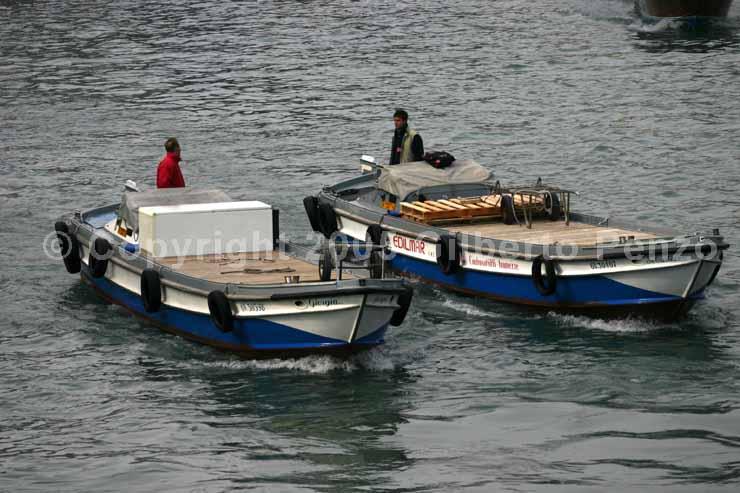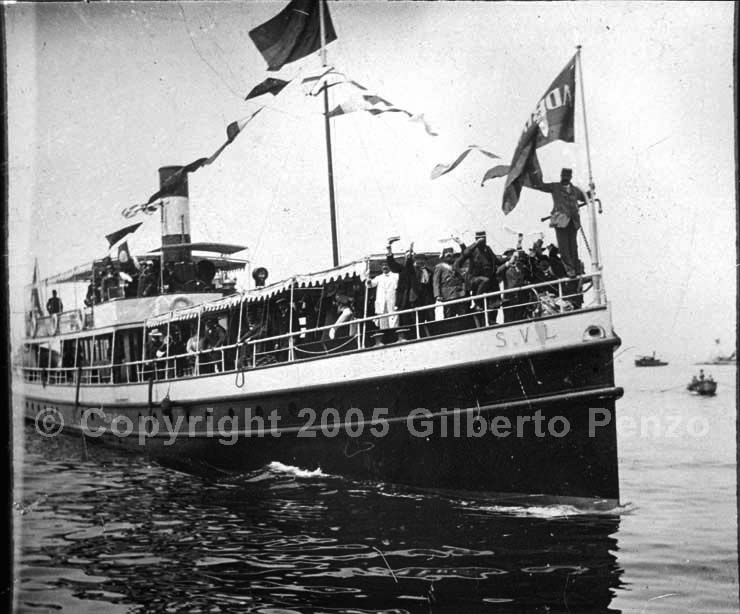|

Mototopo e barche da trasporto merci
E’
nostra convinzione che lo studio delle imbarcazioni non
debba limitarsi solo al passato, principalmente per due
motivi: perché la storia e l’archeologia non si
arrestano ad una data precisa, e perché i manufatti e il
loro uso sopravvivono anche secoli dopo la loro
introduzione continuando, modificandosi, ad adattarsi alle
nuove esigenze, specialmente a Venezia dove ancora, dalla
culla alla bara, si fa ancora tutto in barca.
La
motorizzazione ha provocato prima un tentativo di
adattamento degli scafi nati a remi e a vela al motore
(come il topo,
la comacina,
divenuti mototopo
e motocomacina),
e poi la nascita di tipologie ex-novo con carena planante
a spigolo.
Tanto
che la barca “tipica” veneziana attuale è il cofano,
una veloce barchetta con motore fuoribordo, usato dai
veneziani alla stregua dell’automobile per i
“terrestri”. Barca che per inciso porta un nome
vecchio di almeno sei secoli, infatti il cofano
o copano era la
barca di servizio delle galee e dei vascelli.
L’ultima
ricerca in ordine di tempo che abbiamo condotto, in questo
campo a cavallo fra archeologia industriale e futuro, è
stata sui vaporetti,
in occasione del centenario di fondazione della azienda di
trasporto pubblico veneziano, ACNIL poi ACTV.
Un
campo apparentemente marginale, che invece ci ha rivelato
un percorso secolare di architettura navale, dai primi
mezzi francesi a vapore fino agli hovercraft, attraverso
centinaia di varianti, come si può vedere nel nostro
libro Vaporetti.
Un secolo di trasporto pubblico nelle laguna di Venezia.
We
strongly believe that the study of boats must not be limited
to the past. There are two main reasons for this: because
history and archeology do not come to a stop at a precise
date, and because manufactured objects and their use can
survive for centuries after their introduction. They can be
adapted to new uses, especially in Venice where, even today,
from the cradle to the grave, boats are used for everything.
The
introduction of motors led firstly to an attempt to adapt
rowing and sailing boats for use with motors (for example,
the topo,
the comacina,
which became mototopo
e motocomacina),
and then gave rise to new types of boat with a planar, edged
keel.
Now
the 'typical' Venetian boat is the
cofano, a fast
boat with an outboard motor used by Venetians in the same
way that people on terra firma use cars. These are boats
that carry a name that is at least six centuries old, in
fact the cofano -
or copano - was
the service boat of galleys and ships.
LThe
last piece of research in chronological order that we have
conducted in this field, between industrial archeology and
the future, was about vaporetti, to mark the occasion
of the centenery of the founding of the Venetian public
transport cmpany ACNIL,
now ACTV.
UAn
apparently marginal field thatinstead revealed a fascinating
century of naval architecture, from the first steam vessels,
which were made in France, to the hovercraft, by way of
hundreds of variants, as can be seen in the book
Vaporetti:
A Century of Public Transport on the Venetian

Taxi
veneziano
e
barche per trasporto persone

Motonave Adriatico
Il
piroscafo Adriatico.
Coll. Righetti |